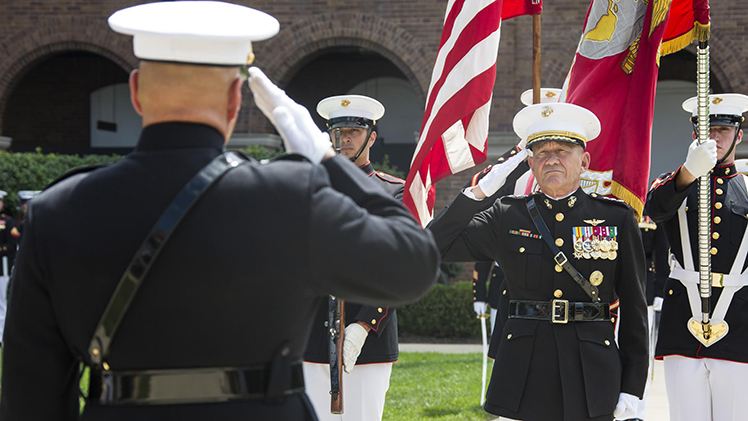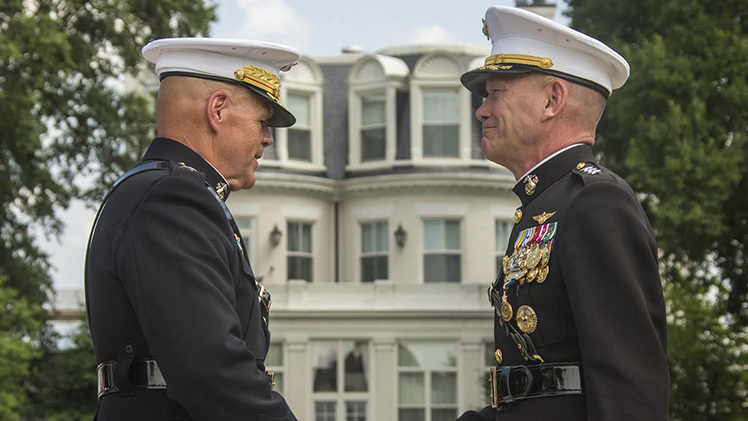
Marine Corps Lt. Gen. Jon Davis retired this week after 37 years of service and was a witness to generational evolution in Marine Corps Aviation. Davis began his career as an AV-8A Harrier pilot, and in his last assignment as deputy commandant for aviation guided the service to fielding the fifth-generation F-35B.
His last three years as DCA included upgrading every type of aircraft the Marines fly, plus wading into the world of unmanned aviation, but it was also hampered by digging out of a readiness hole the service found itself in.
Davis this week left the Marine Corps with a letter summarizing his thoughts on how the service can continue making progress on readiness-building and recapitalization efforts.
When Davis took over Marine Corps Aviation in June 2014, “we were experiencing an enterprise-wide decrease in readiness” after 13 years of war in the Middle East on top of persistent global requirements to be present in Japan and South Korea, deployed in ground-based Special Purpose Marine Air-Ground Task Forces (SP-MAGTFs) in the Mediterranean, and afloat on Amphibious Ready Group/Marine Expeditionary Unit (ARG-MEU) deployments around the world.
Davis wrote that the plane-specific Independent Readiness Reviews he ordered – the ones for the AV-8B, CH- 53E, MV-22 and H-1 aircraft types and for ground safety have been completed, and the IRR for the F/A-18 is ongoing – “have been instrumental in the design of our readiness recovery strategy.”
“A key finding common to all of these reviews emphasized the importance of retaining highly qualified enlisted maintainers – trained properly and provided to the fleet in the correct density,” he wrote.
“Each report discovered a lack of Marines possessing the requisite skills our ready force demands, causing us to reestablish and increase our benchmarks. This is less an issue of individual capability and is more strictly related to density of personnel. Fixing the problem requires both tracking the qualifications and retention of these enlisted maintenance leaders. In order to facilitate change, we have added specific military occupational specialties to our official manpower tracking databases and offered a retention bonus to Marines with critical maintenance qualifications.”
He noted later in the letter that retention will be a particular focus for the Marine Corps in the coming years.
“I’ve learned as the Marine Corps Deputy Commandant for Aviation that it is the imperative to have high-quality, highly trained, motivated and incentivized Marines in the right qualification density to meet and exceed our readiness requirements. We need to look out for our people, and in turn, we will see their efforts, our group efforts, reflect in our achievements. In the future, I believe manpower retention is going to be a big issue for us. It takes a long time to build flight leads and instructors. I think the supply and demand signal from other employers is going to continue to be alluring to our Marines if operational tempo stays high. We are actively fixing the readiness, and that will help with retention. But, as Marines, we all need to be supportive of each other in order to keep our people in the cockpit, keep our training base strong and cultivate experience across our Corps.”

Davis also wrote about the platforms in the service, both those legacy platforms undergoing the readiness recovery efforts and the new platforms coming in to replace them.
On the fixed-wing fighter side, the AV-8B Harriers have come a long way in readiness, he wrote, even if F/A-18 Hornet readiness has plagued the service recently. Both will be replaced by the F-35B, though squadron transition plans have been rearranged to upgrade the Hornets sooner and leverage the Harrier readiness recovery plan to keep those airplanes around a bit longer.
“Efforts from the past two years have put the Marine Corps’ AV-8B Harrier fleet in a much better place, and they are flying more. Since the completing the IRR, we have seen a 26% increase in pilot hours per month, and a 23% increase in squadron Ready Basic Aircraft,” he wrote.
Still, the Marine Corps continues to face questions about why it hasn’t joined the Navy in buying F/A-18E-F Super Hornets as a band-aid until the F-35 can be fully fielded. Without directly addressing this criticism that seems to pop up every year during budget season, Davis wrote that “our 5th gen jet (the F-35) can be quickly configured to a 4th gen bomb truck… The last thing the USMC needs is another 4th gen aircraft program – especially one that can’t be based on an amphib, a [light carrier] like [the Royal Navy’s HMS Queen Elizabeth], or short expeditionary strips ashore. Predicting the future is always difficult- even the smartest of the smart guys get it wrong. We have no idea where we will be fighting or against who in 2025. The USMC has to be ready for the toughest fight. The real question ought to be – why are we building any more 4th gen birds? What we buy in 2025 will be with us for 30-40 years – 4th gen Hornets in 2055-2065? The smarter move is to build 5th gen now.”
Writing about another important aircraft upgrade, Davis said of the heavy-lift helicopter fleet, “we have inducted 21 CH- 53Es into the organizational-level maintenance process so far, and six of those aircraft have been reset and returned to the fleet. By the end of this calendar year we will have completed 17 reset aircraft,” he wrote, adding that the reset Super Stallions have flown 800 hours and are showing sustained readiness and reliability. The entire fleet should be reset in the next three to four years, he wrote. These heavy-lift helos will be replaced by the CH-53K, an engineering and development model (EDM) version of which just recently arrived at Naval Air Station Patuxent River in Maryland to begin testing.
He also ran through a slew of weapons upgrades, noting that “we executed our first RQ-21 (unmanned aerial vehicle) deployment in support of a Marine Expeditionary Unit. We also fired our first APKWS (advanced precision kill weapon system) laser-guided rocket off our Harriers both in Libya and Operation Inherent Resolve, and we continue to bring air power to the fight in the Middle East. We have continued to experiment with and field our next generation electronic warfare (EW) asset, the Intrepid Tiger II, which will ultimately provide tailored EW capability to all of our airborne platforms.”
In closing, Davis offered an optimistic view of the future of Marine Corps Aviation and the ability of his successor, Lt. Gen. Steven Rudder, to handle the upcoming changes and challenges.
“I do know we are on the right path to a fully ready Marine Aviation component. I have full faith that LtGen Steve Rudder is the perfect person to replace me in this position. He is a very talented leader with extreme focus. I also know that we have exactly the right Commandant to put this all together to recover our readiness and keep it on track,” he wrote.
“So while we are a little shy of the finish line, we will get to the finish line.”





